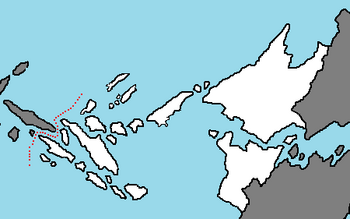Qolaysia: Difference between revisions
No edit summary |
|||
| Line 98: | Line 98: | ||
==Geography== | ==Geography== | ||
According to the country's Coordinating Ministry for Maritime and Investments Affairs, Qolaysia has 3,504 islands (3,056 of which are registered at the [[Coalition of Crown Albatross|C.C.A.]]), around 2,000 of which are inhabited. The largest are Jaba, Bahni (shared with --insert country--), Qolan (shared with --insert country--), Leonrau, and Ojibana. Qolaysia shares land borders with --insert country-- on the island of Bahni and with --insert country-- on the island of Qolan, and maritime borders with [[Ascacia]] and [[Togaria]], with disputes with both Togaria and [[Semalia]]. | |||
At 4,884 metres (16,024 ft), Quncak Baya is Qolaysia's highest peak, and Lake Qoba in Qolan is the largest lake, with an area of 1,145 km2 (442 sq mi). Qolaysia's largest rivers are in Qolan and Bahni and include Qapuas, Qarito, Yamyeramo, Yepik and Kaqakam. They serve as communication and transport links between the island's river settlements where roads are sparse. | |||
Qolaysia's climate tends to be relatively even year-round. Qolaysia has two seasons—a wet season and a dry season—with no extremes of summer or winter. For most of Qolaysia, the dry season falls between May and October with the wet season between November and April. Qolaysia's climate is almost entirely tropical, dominated by the tropical rainforest climate found in every large island of Qolaysia. More cooling climate types do exist in mountainous regions that are 1,300 to 1,500 metres (4,300 to 4,900 feet) above sea level. The oceanic climate (Köppen Cfb) prevails in highland areas adjacent to rainforest climates, with reasonably uniform precipitation year-round. | |||
==Demographics== | ==Demographics== | ||
Revision as of 22:08, 5 October 2020
Federation of Qolaysia Qolaysia | |
|---|---|
|
Flag | |
 | |
| Capital | Leonrau |
| Official languages | Qolaysian |
| Recognised national languages | Togarian |
| Ethnic groups | Jabanesian, Paransian, Togarian |
| Demonym(s) | Qolaysian |
| Government | |
| Abiel Kennard | |
| Population | |
• 2020 estimate | 24,384,000 |
| Date format | mm-dd-yyyy |
The Federation of Qolaysia, most commonly known as Qolaysia, is a nation in the Coalition of Crown Albatross located on the continent of Adula, with maritime borders with Ascacia and Togaria. It consists of more than three thousand islands. The sovereign state is a presidential, constitutional federation with an elected legislature. It has 34 provinces, of which five have special status. The country's capital, Leonrau, is the most populous urban area in the country. The country shares land borders with --insert country--. Despite its urban population and densely populated regions, Qolaysia has vast areas of wilderness that support one of the world's highest levels of biodiversity.
The Qolaysian archipelago has been a valuable region for trade since at least the 8th century when the Emmirian and later Skithan Empires traded with entities from mainland Adula and the subcontinent. Local rulers gradually absorbed foreign influences from the early centuries and Qolaysian kingdoms flourished. Sunni traders and Sufi scholars brought Islam, while Verdusans and Euronians introduced Christianity through colonisation. Although sometimes interrupted by the Quetanans, Durnstaal, and even Yuaneze, the Togarians were the foremost colonial power for much of their 350-year presence in the archipelago. The concept of "Qolaysia" as a nation-state emerged in the early 20th century and the country proclaimed its independence in 1945. However, it was not until 1949 that the Togarians recognised Qolaysia's sovereignty following an armed and diplomatic conflict between the two and the outset of the World War. In recent years, tensions between Togaria and Qolaysia have escalated over the resource-rich and strategic location of the archipeligo, resulting in numerous clashes including the ongoing Togana War.
Qolaysia consists of hundreds of distinct native ethnic and linguistic groups, with the largest one being the Jabanesian. A shared identity has developed with the motto "Bhinneka Tunggal Ika" ("Unity in Diversity" literally, "many, yet one"), defined by a national language, ethnic diversity, religious pluralism within a Muslim-majority population, and a history of colonialism and rebellion against it.
History
Geography
According to the country's Coordinating Ministry for Maritime and Investments Affairs, Qolaysia has 3,504 islands (3,056 of which are registered at the C.C.A.), around 2,000 of which are inhabited. The largest are Jaba, Bahni (shared with --insert country--), Qolan (shared with --insert country--), Leonrau, and Ojibana. Qolaysia shares land borders with --insert country-- on the island of Bahni and with --insert country-- on the island of Qolan, and maritime borders with Ascacia and Togaria, with disputes with both Togaria and Semalia.
At 4,884 metres (16,024 ft), Quncak Baya is Qolaysia's highest peak, and Lake Qoba in Qolan is the largest lake, with an area of 1,145 km2 (442 sq mi). Qolaysia's largest rivers are in Qolan and Bahni and include Qapuas, Qarito, Yamyeramo, Yepik and Kaqakam. They serve as communication and transport links between the island's river settlements where roads are sparse.
Qolaysia's climate tends to be relatively even year-round. Qolaysia has two seasons—a wet season and a dry season—with no extremes of summer or winter. For most of Qolaysia, the dry season falls between May and October with the wet season between November and April. Qolaysia's climate is almost entirely tropical, dominated by the tropical rainforest climate found in every large island of Qolaysia. More cooling climate types do exist in mountainous regions that are 1,300 to 1,500 metres (4,300 to 4,900 feet) above sea level. The oceanic climate (Köppen Cfb) prevails in highland areas adjacent to rainforest climates, with reasonably uniform precipitation year-round.

